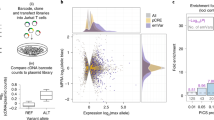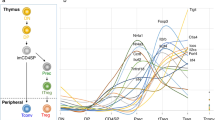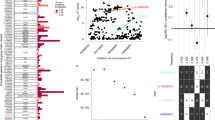Abstract
CD4+ and CD8+ T cells have a central role in the immune system due to their ability to protect against infection and cancer development without targeting self. Consequently, changes in CD4+ and CD8+ T-cell homeostasis can be indicative of an array of serious illnesses, ranging from viral infections to autoimmune diseases. In addition to environmental influences, there is evidence for a genetic component regulating the proportion of CD4+ and CD8+ T cells in lymphoid organs. Indeed, identifying the genetic determinants defining the frequency of the T-cell subsets is critical as it may reveal a targetable genetic pathway to modulate CD4+ and CD8+ T-cell numbers, which could be of clinical relevance for multiple disease settings. In this study, we aim to uncover non-MHC genetic factors regulating the proportion of CD4+ and CD8+ T cells in lymphoid tissues. By investigating linkage analyses on three independent F2 cohorts, namely a rat F2 (BBDP × ACI.1U.LYP) cohort, a mouse 3A9 TCR transgenic F2 (B10.BR × NOD.H2k) cohort and a mouse F2 (C57BL/6 × FVB/N) cohort, we uncover an orthologous non-MHC locus on rat chromosome 1 and mouse chromosome 7 that is linked to T-cell proportion amongst total lymphocytes.
This is a preview of subscription content, access via your institution
Access options
Subscribe to this journal
Receive 6 digital issues and online access to articles
$119.00 per year
only $19.83 per issue
Buy this article
- Purchase on Springer Link
- Instant access to full article PDF
Prices may be subject to local taxes which are calculated during checkout






Similar content being viewed by others
References
Frazer IH, Mackay IR, Crapper RM, Jones B, Gust ID, Sarngadharan MG et al. Immunological abnormalities in asymptomatic homosexual men: correlation with antibody to HTLV-III and sequential changes over two years. Q J Med 1986; 61: 921–933.
Taylor JM, Fahey JL, Detels R, Giorgi JV . CD4 percentage, CD4 number, and CD4:CD8 ratio in HIV infection: which to choose and how to use. J Acquir Immune Defic Syndr 1989; 2: 114–124.
Lu W, Mehraj V, Vyboh K, Cao W, Li T, Routy JP . CD4: CD8 ratio as a frontier marker for clinical outcome, immune dysfunction and viral reservoir size in virologically suppressed HIV-positive patients. J Int AIDS Soc 2015; 18: 20052.
Gratama JW, Fibbe WE, Naipal AM, Slats J, Stijnen T, D'Amaro J et al. Cytomegalovirus immunity and T lymphocytes in bone marrow donors and acute graft-versus-host disease. Bone marrow Transplant 1986; 1: 141–146.
Luz Correa B, Ornaghi AP, Cerutti Muller G, Engroff P, Pestana Lopes R, Gomes da Silva Filho I et al. The inverted CD4:CD8 ratio is associated with cytomegalovirus, poor cognitive and functional states in older adults. Neuroimmunomodulation 2014; 21: 206–212.
Pender MP . CD8+ T-cell deficiency, Epstein-Barr virus infection, vitamin D deficiency, and steps to autoimmunity: a unifying hypothesis. Autoimmune Dis 2012; 2012: 189096.
Zander AR, Reuben JM, Johnston D, Vellekoop L, Dicke KA, Yau JC et al. Immune recovery following allogeneic bone marrow transplantation. Transplantation 1985; 40: 177–183.
Socie G, Ritz J . Current issues in chronic graft-versus-host disease. Blood 2014; 124: 374–384.
Hussein MR, Fathi NA, El-Din AM, Hassan HI, Abdullah F, Al-Hakeem E et al. Alterations of the CD4(+), CD8 (+) T cell subsets, interleukins-1beta, IL-10, IL-17, tumor necrosis factor-alpha and soluble intercellular adhesion molecule-1 in rheumatoid arthritis and osteoarthritis: preliminary observations. Pathol Oncol Res 2008; 14: 321–328.
McInerney MF, Clough JD, Senitzer D, Cathcart MK . Two distinct subsets of patients with systemic lupus erythematosus. Clin Immunol Immunopathol 1988; 49: 116–132.
Faustman D, Eisenbarth G, Daley J, Breitmeyer J . Abnormal T-lymphocyte subsets in type I diabetes. Diabetes 1989; 38: 1462–1468.
Ferreira MA, Mangino M, Brumme CJ, Zhao ZZ, Medland SE, Wright MJ et al. Quantitative trait loci for CD4:CD8 lymphocyte ratio are associated with risk of type 1 diabetes and HIV-1 immune control. Am J Hum Genet 2010; 86: 88–92.
Brodin P, Davis MM . Human immune system variation. Nat Rev Immunol 2017; 17: 21–29.
Brodin P, Jojic V, Gao T, Bhattacharya S, Angel CJ, Furman D et al. Variation in the human immune system is largely driven by non-heritable influences. Cell 2015; 160: 37–47.
Carr EJ, Dooley J, Garcia-Perez JE, Lagou V, Lee JC, Wouters C et al. The cellular composition of the human immune system is shaped by age and cohabitation. Nat Immunol 2016; 17: 461–468.
De Jager PL, Hacohen N, Mathis D, Regev A, Stranger BE, Benoist C . ImmVar project: Insights and design considerations for future studies of ’healthy’ immune variation. Semin Immunol 2015; 27: 51–57.
Chen J, Harrison DE . Quantitative trait loci regulating relative lymphocyte proportions in mouse peripheral blood. Blood 2002; 99: 561–566.
Myrick C, DiGuisto R, DeWolfe J, Bowen E, Kappler J, Marrack P et al. Linkage analysis of variations in CD4:CD8 T cell subsets between C57BL/6 and DBA/2. Genes Immun 2002; 3: 144–150.
Roch F, Bach MA . Strain differences in mouse cellular responses to Mycobacterium lepraemurium and BCG subcutaneous infections. I. Analysis of cell surface phenotype in local granulomas. Clin Exp Immunol 1990; 80: 332–338.
Rymarchyk SL, Lowenstein H, Mayette J, Foster SR, Damby DE, Howe IW et al. Widespread natural variation in murine natural killer T-cell number and function. Immunology 2008; 125: 331–343.
Sim BC, Aftahi N, Reilly C, Bogen B, Schwartz RH, Gascoigne NR et al. Thymic skewing of the CD4/CD8 ratio maps with the T-cell receptor alpha-chain locus. Curr Biol 1998; 8: 701–704.
Mainali ES, McMurray DN . Protein deficiency induces alterations in the distribution of T-cell subsets in experimental pulmonary tuberculosis. Infect Immun 1998; 66: 927–931.
Callahan JE, Kappler JW, Marrack P . Unexpected expansions of CD8-bearing cells in old mice. J Immunol 1993; 151: 6657–6669.
Utsuyama M, Hirokawa K . Age-related changes of splenic T cells in mice—a flow cytometric analysis. Mech Ageing Dev 1987; 40: 89–102.
Amadori A, Zamarchi R, De Silvestro G, Forza G, Cavatton G, Danieli GA et al. Genetic control of the CD4/CD8 T-cell ratio in humans. Nat Med 1995; 1: 1279–1283.
Duarte N, Penha-Goncalves C . The MHC locus controls size variations in the CD4 compartment of the mouse thymus. Immunogenetics 2001; 53: 662–668.
Germain RN . T-cell development and the CD4-CD8 lineage decision. Nat Rev Immunol 2002; 2: 309–322.
Kraal G, Weissman IL, Butcher EC . Genetic control of T-cell subset representation in inbred mice. Immunogenetics 1983; 18: 585–592.
Pichugin AV, Petrovskaya SN, Apt AS . H2 complex controls CD4/CD8 ratio, recurrent responsiveness to repeated stimulations, and resistance to activation-induced apoptosis during T cell response to mycobacterial antigens. J Leukoc Biol 2006; 79: 739–746.
Damoiseaux JG, Cautain B, Bernard I, Mas M, van Breda Vriesman PJ, Druet P et al. A dominant role for the thymus and MHC genes in determining the peripheral CD4/CD8 T cell ratio in the rat. J Immunol 1999; 163: 2983–2989.
Tuncel J, Haag S, Yau AC, Norin U, Baud A, Lonnblom E et al. Natural polymorphisms in Tap2 influence negative selection and CD4ratioCD8 lineage commitment in the rat. PLoS Genet 2014; 10: e1004151.
Colle E, Guttmann RD, Seemayer T . Spontaneous diabetes mellitus syndrome in the rat. I. Association with the major histocompatibility complex. J Exp Med 1981; 154: 1237–1242.
Jacob HJ, Pettersson A, Wilson D, Mao Y, Lernmark A, Lander ES . Genetic dissection of autoimmune type I diabetes in the BB rat. Nat Genet 1992; 2: 56–60.
Akkaraju S, Ho WY, Leong D, Canaan K, Davis MM, Goodnow CC . A range of CD4 T cell tolerance: partial inactivation to organ-specific antigen allows nondestructive thyroiditis or insulitis. Immunity 1997; 7: 255–271.
Ho WY, Cooke MP, Goodnow CC, Davis MM . Resting and anergic B cells are defective in CD28-dependent costimulation of naive CD4+ T cells. J Exp Med 1994; 179: 1539–1549.
Allen PM, Matsueda GR, Evans RJ, Dunbar Jr JB, Marshall GR, Unanue ER . Identification of the T-cell and Ia contact residues of a T-cell antigenic epitope. Nature 1987; 327: 713–715.
Nelson CA, Viner NJ, Unanue ER . Appreciating the complexity of MHC class II peptide binding: lysozyme peptide and I-Ak. Immunol Rev 1996; 151: 81–105.
Johnson NA, Carland F, Allen PM, Glimcher LH . T cell receptor gene segment usage in a panel of hen-egg white lysozyme specific, I-Ak-restricted T helper hybridomas. J Immunol 1989; 142: 3298–3304.
Nabarra B, Mulotte M, Casanova M, Godard C, London J . Ultrastructural study of the FVB/N mouse thymus: presence of an immature epithelial cell in the medulla and premature involution. Dev Comp Immunol 2001; 25: 231–243.
Franckaert D, Schlenner SM, Heirman N, Gill J, Skogberg G, Ekwall O et al. Premature thymic involution is independent of structural plasticity of the thymic stroma. Eur J Immunol 2015; 45: 1535–1547.
Collin R, Dugas V, Pelletier AN, Chabot-Roy G, Lesage S . The mouse idd2 locus is linked to the proportion of immunoregulatory double-negative T cells, a trait associated with autoimmune diabetes resistance. J Immunol 2014; 193: 3503–3512.
Pelletier AN, Guimont-Desrochers F, Ashton MP, Brodnicki TC, Lesage S . The size of the plasmacytoid dendritic cell compartment is a multigenic trait dominated by a locus on mouse chromosome 7. J Immunol 2012; 188: 5561–5570.
Guimont-Desrochers F, Cappello ZJ, Chagnon M, McDuffie M, Lesage S . Cutting edge: genetic characterization of IFN-producing killer dendritic cells. J Immunol 2009; 182: 5193–5197.
Burt RA, Watkins L, Tan IK, Wang N, Quirk F, Mackin L et al. An NZW-derived interval on chromosome 7 moderates sialadenitis, but not insulitis in congenic nonobese diabetic mice. J Immunol 2010; 184: 859–868.
Karlsson J, Zhao X, Lonskaya I, Neptin M, Holmdahl R, Andersson A . Novel quantitative trait loci controlling development of experimental autoimmune encephalomyelitis and proportion of lymphocyte subpopulations. J Immunol 2003; 170: 1019–1026.
Karlsson J, Johannesson M, Lindvall T, Wernhoff P, Holmdahl R, Andersson A . Genetic interactions in Eae2 control collagen-induced arthritis and the CD4+/CD8+ T cell ratio. J Immunol 2005; 174: 533–541.
Sorge RE, Mapplebeck JC, Rosen S, Beggs S, Taves S, Alexander JK et al. Different immune cells mediate mechanical pain hypersensitivity in male and female mice. Nat Neurosci 2015; 18: 1081–1083.
Chabod M, Pedros C, Lamouroux L, Colacios C, Bernard I, Lagrange D et al. A spontaneous mutation of the rat Themis gene leads to impaired function of regulatory T cells linked to inflammatory bowel disease. PLoS Genet 2012; 8: e1002461.
Fu G, Vallee S, Rybakin V, McGuire MV, Ampudia J, Brockmeyer C et al. Themis controls thymocyte selection through regulation of T cell antigen receptor-mediated signaling. Nat Immunol 2009; 10: 848–856.
Arndt T, Jorns A, Weiss H, Tiedge M, Hedrich HJ, Lenzen S et al. A variable CD3(+) T-cell frequency in peripheral blood lymphocytes associated with type 1 diabetes mellitus development in the LEW.1AR1-iddm rat. PloS One 2013; 8: e64305.
Morel L, Rudofsky UH, Longmate JA, Schiffenbauer J, Wakeland EK . Polygenic control of susceptibility to murine systemic lupus erythematosus. Immunity 1994; 1: 219–229.
Mohan C, Yu Y, Morel L, Yang P, Wakeland EK . Genetic dissection of Sle pathogenesis: Sle3 on murine chromosome 7 impacts T cell activation, differentiation, and cell death. J Immunol 1999; 162: 6492–6502.
Colle E, Fuks A, Poussier P, Edouard P, Guttmann RD . Polygenic nature of spontaneous diabetes in the rat. Permissive MHC haplotype and presence of the lymphopenic trait of the BB rat are not sufficient to produce susceptibility. Diabetes 1992; 41: 1617–1623.
Lesage S, Hartley SB, Akkaraju S, Wilson J, Townsend M, Goodnow CC . Failure to censor forbidden clones of CD4 T cells in autoimmune diabetes. J Exp Med 2002; 196: 1175–1188.
Taketo M, Schroeder AC, Mobraaten LE, Gunning KB, Hanten G, Fox RR et al. FVB/N: an inbred mouse strain preferable for transgenic analyses. Proc Natl Acad Sci USA 1991; 88: 2065–2069.
Peterson DA, DiPaolo RJ, Kanagawa O, Unanue ER . Quantitative analysis of the T cell repertoire that escapes negative selection. Immunity 1999; 11: 453–462.
Liston A, Lesage S, Gray DHD, O’Reilly LA, Strasser A, Fahrer AM et al. Generalized resistance to thymic deletion in the NOD mouseA polygenic trait characterized by defective induction of Bim. Immunity 2004; 21: 817–830.
Acknowledgements
This work was supported by a grant from the Canadian Diabetes Association (OG-3-13-4018) to SL. SL holds a Senior scholarship and RC holds studentship from Fonds de recherche du Québec – Santé.
Author information
Authors and Affiliations
Corresponding authors
Ethics declarations
Competing interests
The authors declare no conflict of interest.
Additional information
Supplementary Information accompanies this paper on Genes and Immunity website
Supplementary information
Rights and permissions
About this article
Cite this article
Franckaert, D., Collin, R., Dooley, J. et al. An orthologous non-MHC locus in rats and mice is linked to CD4+ and CD8+ T-cell proportion. Genes Immun 18, 118–126 (2017). https://doi.org/10.1038/gene.2017.9
Received:
Revised:
Accepted:
Published:
Issue Date:
DOI: https://doi.org/10.1038/gene.2017.9
This article is cited by
-
Cell death in cancer in the era of precision medicine
Genes & Immunity (2019)



